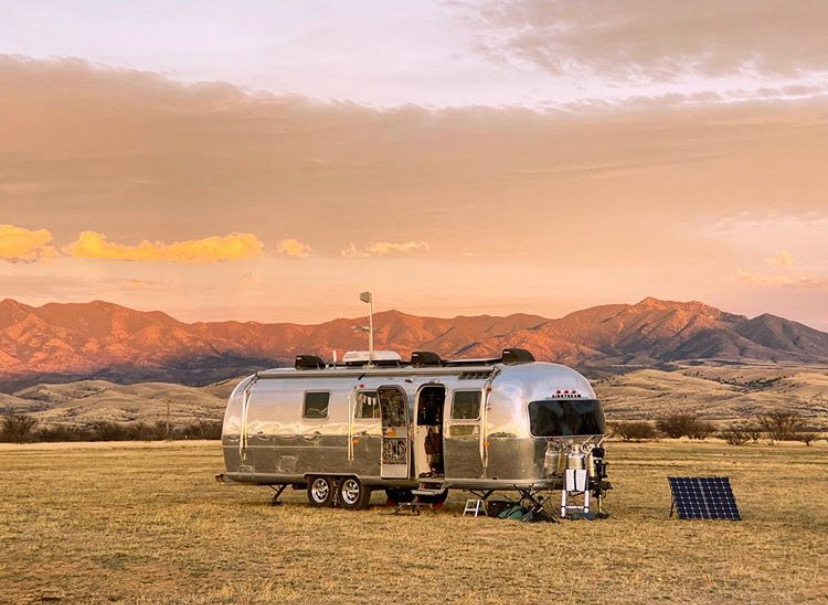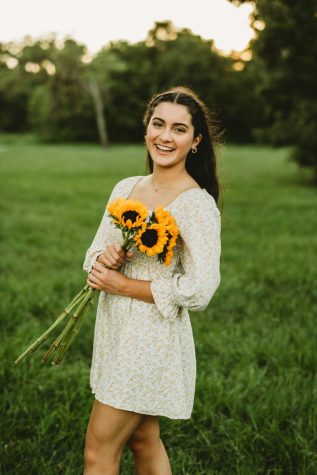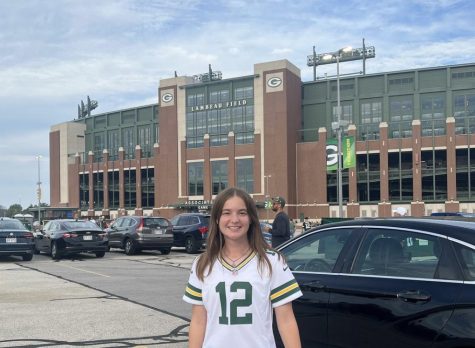Tiny Living: Freedom or Confinement?
The Longnecker family’s Airstream in front of the mountains of Arizona.
September 2, 2020
In recent decades, tiny living has been on the rise around the world, and as a result, conversations about the quality of the lifestyle have blossomed. Taking time to listen to the experiences and advice of others helps to provide a broader understanding of what living tiny is like. Living tiny can best be described as living within a minimized space in attempts to simplify certain aspects of life as well as achieve greater freedom. Forms of tiny living exist through tiny homes, renovated buses and vans, houseboats, yurts, earthships, shipping containers, treehouses and suspended houses, and cabins. These spaces can range from self-built ventures to specially designed works of art. This article features various perspectives on tiny living throughout the country. Those that range from self-converted vans and school buses to unique and functional tiny homes. Strap in for this honest, beautiful, and unique ride through the lives of tiny dwellers far and wide.
@nicolettenotes
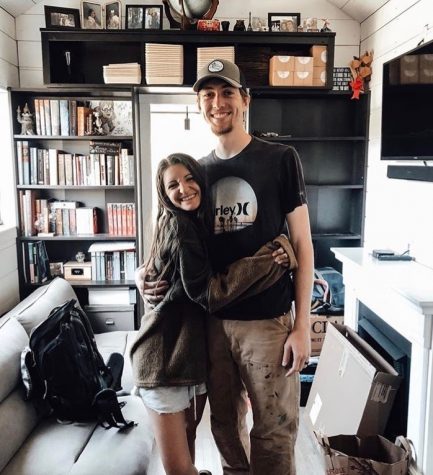
First we begin with Nicolette, a young etsy artist living in California with her partner, Michael inside their self-built tiny home. She practices a low-waste, sustainable, and vegan lifestyle while promoting positivity and acceptance towards herself and others. Her and Michael met when they were both college students at UC Berkeley, once they decided they wanted to live together, thoughts of high rent and infamous Berkley housing rates caused them to search for a more creative solution. So, they decided to embark on their tiny house journey with zero construction experience for the heck of it and have the experience of a lifetime. After moving into her DIY tiny home, Nicolette found that a beautiful part of living tiny is that she doesn’t “physically have the space” to own things that she doesn’t need or that “truly bring [her] joy, but it also shows you how simple life can be if you let it”. She also loves that it’s so “magical to live in such a beautiful space where you look at the walls and remember the day you put them up”. Being able to make memories and accomplish milestones within their unique tiny house means the world to Nicolette and Michael. The tiny house symbolizes their simplistic relationship however fixed with complex challenges and successes. As a blissful couple who values the most simplistic sources of joy, they often find themselves moving “around each other like we are in a little dance” within their home. Nicolette says that their charming home “serves as my photo shoot area, business hub, study space, and so much more. Building it ourselves really allowed us to use our creativity and make it exactly what we wanted it to be”. Nicolette & Michael were able to utilize their space as much as possible, but never feel like their house is limited. Nicolette explains that the “house has space, it has room. It isn’t filled with things that overwhelm and stress us out”. Overall, she loves “how accessible everything is and also how [she] know(s) where every little thing is in the house”. As of recently, Nicolette and Michael embarked on a new journey from Berkley to Malibu, where they were unable to find a parking spot for their tiny house. It seems to be one of the big challenges of tiny living, but they hope to reunite with their tiny home in the future. In the meantime, they will stay in a 700 square-foot guest house that feels like a “mansion” to them. She becomes very sad when thinking about leaving her tiny home, but has found “so much freedom by allowing [her] rent to be lower and therefore [she] did not have to work 40 hours a week at a job that [she] wasn’t fully happy at”. For Nicolette, tiny living was a way for her to live her best life while enjoying the simple things. From one tiny space to another, Nicolette continues to enjoy the comfort of an average home with the special ability to explore her true passions with more than enough space for her ever growing life journey.
@hanzian_bus
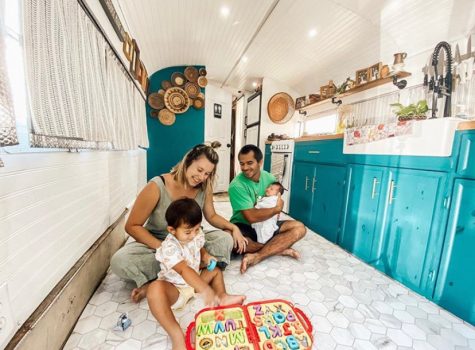
Ian and Hannah live in a 1991 renovated school bus as they enjoy making life-long memories on the road with their two children, Nora and Atlas. The couple appreciates the ability to be flexible with their daily routines and venture off to new experiences. They value the ability to teach their children to appreciate a “simple but more meaningful life.” Their journey began after purchasing their bus in late 2016, the couple worked hard to convert it into a home, wrapping up the transformation in late 2018. Documenting their milestones on their Instagram, where the aesthetic color scheme and homey atmosphere of the bus is showcased. To Ian and Hannah, “owning less things and experiencing more as a family” are the best aspects of tiny living. When they switched to the lifestyle, the lack of payments and debt allowed them to, “invest that money into experiences as a family” and adopt a more minimalistic mindset. They value the option to live off-grid, citing the unparalleled freedom of life on wheels. The family gets to spend a lot of quality time together, and they value routine and structure when they are on the road. They do not normally set specific time frames, but they do, “feel that it’s important to have a structure such as a bath and bedtime routine” for Nora and Atlas, because it provides stability even when they drive to different locations. After taking the steps to change their lifestyle, they were able to sustain themselves without having to work, “every waking second to pay the bills [and] pay for a home”. The flexibility does not stop there though! The family is able to adapt the bus to their changing needs. Some of their ideas include adding storage on the side of the bus for outdoor items like rugs and chairs, installing a rack for bikes, and redoing their couch design to provide for more indoor storage space. Ian and Hannah treasure the fact that tiny living brings their family, “close together (literally!)” and has made them more adaptable and, “open to whatever life may throw at [them].” Tiny living has changed the quality of their lives for the better, but they are not immune to challenges on the road. Though living in their bus allows the family of four to travel extensively, they are consequently away from their extended family when out on the road. When living in a renovated school bus some problems cannot be fixed as easily. Hannah says that the mechanical issues and repairs are, “probably the most costly side of bus life” after the build. They run into dilemmas such as mechanical problems and pay close attention to “staying on top of any issues or repairs” to maintain their lifestyle in the 1991 bus. From mechanical repairs to adventurous road trips from one location to the next, Ian, Hannah, Nora, Atlas, are always making memories in their one-of-a-kind home.
@deannadunn/@jamesrcdunn
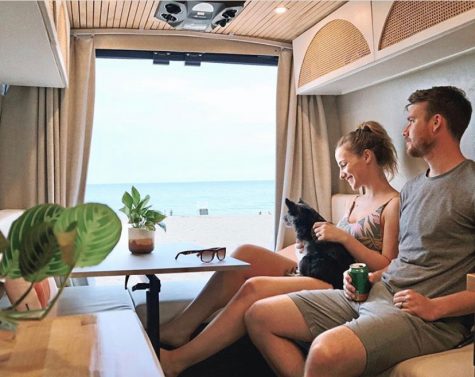
While many long-term roadtrippers would travel in some type of RV, Deanna and James travel in their converted van. They take an alternate approach to the tiny lifestyle and traveling. Though being so close together for days, weeks, or even months may not be the idea of a getaway for some couples, Deanna and James love being side by side on their journeys. They take their van on long trips and appreciate the convenience of having a second home on the road. It is not uncommon for the couple to drive their van to the beach for a cup of coffee or head to a national park with all the belongings they need in tow. Traveling in the van allows for unmatched flexibility, but there is limited space on extended stretches. The couple puts a lot of thought into the items they take, weighing the choices and whether or not the items will be worth the space taken up. Though storage can be a challenge, the couple finds that there is plenty of space to explore at all of their travel destinations. A difficult aspect of tiny living for Deanna and James is finding safe places to park. However, the more traveling they do, the easier it gets. Deanna shared about Harvest Hosts, a website they use often. Harvest Hosts is a membership with farms, wineries, museums and similar types of areas for travelers on wheels to stay overnight. They appreciate being able to bring everything they need everywhere they travel. They are, “most grateful for the freedom that van life gives [them],” citing their fully self-sustainable and off grid travel, which has been especially favorable over the course of the pandemic. On a typical day without much driving, Deanna and James like to find a nice spot to drink their coffee in the morning. Not many homes allow for a view of the Pacific Coast one day and Yellowstone National Park another! Their extended expeditions on the road do require advance preparation. Deanna and James work lots of extra hours beforehand to allow for more time on the road. This is a great way to allow them to relax on the road and not worry about bills. The couple loves taking trips in their van to “disconnect” and take a break from their normal schedules. The couple enjoys having a larger space to host friends and work on projects. They recently returned from a lengthy road trip and have moved into a new house with more space for projects like future van builds and home DIYs. Starting this fall, when they are not using their van, they will rent it out for others to take trips in. Deanna and James treasure both exploring in their van and residing in a stationary home.
@tinyshinyhome
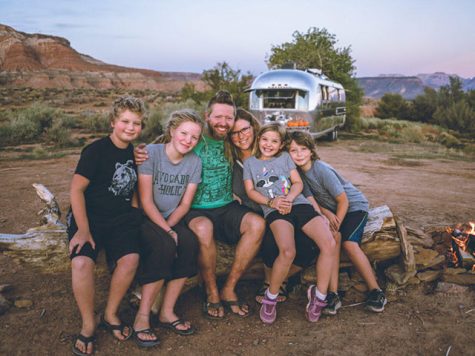
Jonathon and Ashley Longnecker live with their four kids in their renovated 1972 Airstream bus with a charming parking spot in Cochise County, Arizona. After traveling the world full-time, the Longneckers decided to settle down in the desert to pursue an off-grid lifestyle on their beautiful homestead. Acquiring their land involved a complicated and lengthy process involving rezoning of the acreage, but eventually the land became their own right in the midst of the global pandemic. Before settling down, the adventurers explored the US in their impressive, off-grid Airstream with some of their favorite national parks being “Dry Tortugas, Glacier, Zion, and Organ Pipe Cactus; [they] also love finding off-grid places to camp for extended periods. [They] really love Ajo, Angel Peak, and Trona Pinnacles”. While traveling the family utilized a concept known as boondocking; a form of camping, typically for free without connection to water, electricity, or sewage. After exploring, Jonathon and Ashley chose to nestle in Cochise County, because they “love the people, the landscapes, and the huge diversity of ecosystems [there]”. Coming from a big subdivision on the outskirts of a big city, we spent so much time taking care of the house that we never got to do anything!”, but noting that they still miss things like “long hot showers, a bed [they] don’t have to convert to a table every day, a toilet that flushes, and Chick-fil-a”. However, they could never go back to their previous lifestyle because, “traveling has unlocked a deep love of nature, adventure, and exploration” they never knew they had. From this realization came another that the “minimal, intentional lifestyle is so important”, their kids “are loving all the new projects [they] have to do here on the property, and the opportunity to observe wildlife over longer periods of time”. Projects involving figuring “out permanent water storage and transport, big building projects, and currently fencing”. While managing their homestead is a priority, so is homeschooling their kids and becoming closer as a family. The family notes that they “have loads more time to spend together so [they] just keep getting closer”. As their children continue growing and becoming more individualistic, Jonathon and Ashley plan on eventually using their 11 acres to “have tiny buildings for everyone and even more room to spread out”. The Longneckers continue to complete various homestead projects and go on endless adventures that reward them with new knowledge and unforgettable experiences. Their newest adventure was welcoming “a puppy who loves to be right in the middle of everything”. Their family will always love having “more mental space to focus on the next adventure or project. They “don’t feel tied down or tethered by [their] stuff.”, achieving a sense of freedom and ambition that a more average suburban lifestyle could never give them.
ADVICE COLUMN
- @nicolettenotes
When living with another in your tiny space a big concern is having time and space to oneself. Many times you may feel overwhelmed, but Nicolette offers that “you can always go on a drive, a walk, or go see a friend if you are feeling you need some time by yourself”. When beginning her tiny house journey Nicolette recalls utilizing “youtube, reading books, blogs, & asking a few other tiny house people for advice before [her and Michael] started building, but honestly we just took it day by day”. Throughout this journey Nicolette does mention that “you might have to make a few ‘sacrifices’ ” in the design of your house but it really helps you realize what you prioritize in your everyday life and [she] really enjoyed that process”. Her truthful advice is, “To never take it for granted. [Her and Michael] really did take in each day [they] were able to live in [their] tiny house but now that [they] might not be able to for the next year, [she] wish(es) she took it in a little bit more. It truly is magical to live in such a beautiful space where you look at the walls and remember the day you put them up.”
- @hanzian_bus
Ian and Hannah believe that “if your dreams don’t scare you, they aren’t big enough”. This applies to going all-in on the tiny lifestyle and living your best life. With things like building your own tiny house, beginning van life, renovating a vehicle into an unconventional living space, or absolutely anything that appears too daunting, they encourage that “you really just need to go for it!”. With tiny homes, they can many times be overpriced and overhyped, so finding a good balance is key to making the most of your money. The couple finds that they see “a ‘tiny house community’ selling tiny homes for the price of a condo or apartment or even a stand alone that’s bigger is kind of odd”. It varies person-to-person, but choosing your tiny space requires considerations based on your lifestyle and financial situation. An important thing for families with children such as Ian and Hannah’s is,“to have a structure such as a bath and bedtime routine for the kids because that shows stability even when we are in a new town.”
- @deannadunn/@jamescrdunn
Deanna urges anyone thinking about tiny living to, “try it out first!” She recommends websites such as outdoorsy.com to rent vans and busses. Deanna and James started out with a camper, but then decided to get a van. Vans are more versatile, and the couple preferred how vans are able to fit most places and are, “stealthier and easier to get around” in. As mentioned earlier in the piece, the couple recommends Harvest Hosts for travelers on wheels to find places to stay overnight. Another piece of advice Deanna offered was to plan out what you need and what you do not need. This makes it more comfortable when traveling and better for space conservation in the tiny area.
- @tinyshinyhome
When approaching tiny life Jonathan and Ashley recommend to “be flexible. Modern life is all about leveling out the curves. As you minimize, simplify, or travel, your highs will be higher, but your lows will be lower. Keep that in mind and take the catastrophes in stride. The bonus is that you’ll have amazing experiences you will remember for the rest of your life. Second, remember why you’re doing it. Simplifying without a deeper reason can be exhausting, and you need to stay motivated”. They found out that initially when embarking on their Airstream reno journey it “was expensive, and [they] took time off work and pulled from savings to get it done. That was pretty stressful. However, in the years since, the renovated Airstream has allowed [them] to boondock and camp for free, lowering [their] expenses. Campgrounds average $30+ a night so [they] had a budget of close to $1,000/mo for camping! After the renovation, it was closer to $250/mo. In addition, [they] learned how to work on everything in the trailer so that saved [them] a bunch of money, too.”
@tinyshinyhome
@nicolettenotes
- INSTAGRAM: https://www.instagram.com/nicolettenotes/
@deannadunn
- INSTAGRAM: https://www.instagram.com/deannadunn/?hl=en
@hanzian_bus
- INSTAGRAM: https://www.instagram.com/hanzian_bus/?hl=en


